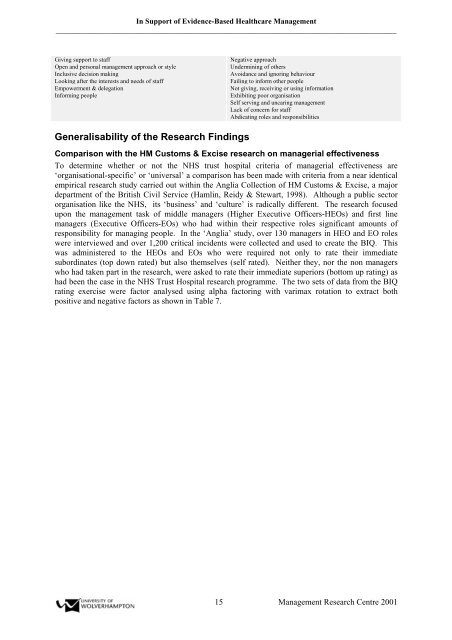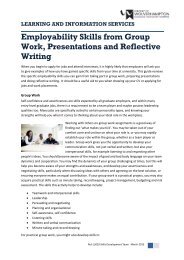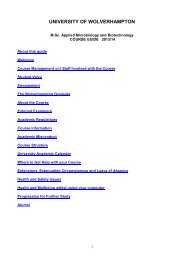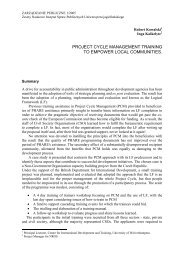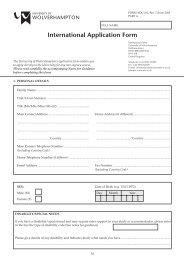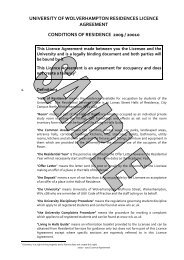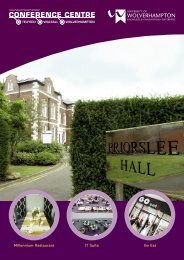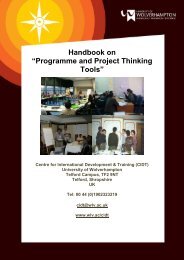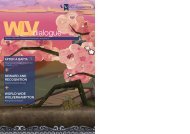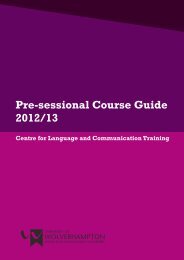<strong>In</strong> <strong>Support</strong> <strong>of</strong> <strong>Evidence</strong>-<strong>Based</strong> <strong>Healthcare</strong> <strong>M<strong>an</strong>agement</strong>_________________________________________________________________________________________A comparison <strong>of</strong> the ‘negative’ factors across all three data sets also reveals a high degree <strong>of</strong>similarity <strong>an</strong>d coincidence. Two <strong>of</strong> the five ‘top-down’ rated criteria, namely ‘Lack <strong>of</strong> concern forstaff ‘ <strong>an</strong>d ‘Abdicating from roles <strong>an</strong>d responsibilities’, appear to be completely perspective-specific,as do two str<strong>an</strong>ds <strong>of</strong> two <strong>of</strong> the ‘self’ rated criteria, namely ‘Negative approach’ <strong>an</strong>d ‘Exhibiting poororg<strong>an</strong>isation’.Table 5. Comparison <strong>of</strong> the ‘bottom up’, ‘self’ <strong>an</strong>d ‘top down’ rated criteria <strong>of</strong> m<strong>an</strong>agerialeffectivenessPOSITIVE FACTORSFactor ‘Bottom Up’ Rated Factor ‘Self’ Rated Factor ‘Top Down’ Rated1 Org<strong>an</strong>isation Pl<strong>an</strong>ning &<strong>Support</strong>ing2 Open & Personal <strong>M<strong>an</strong>agement</strong>Style1 Active <strong>Support</strong>ive Leadership 1 Pl<strong>an</strong>ning <strong>an</strong>dOrg<strong>an</strong>isation/Giving <strong>Support</strong> toStaff2 <strong>In</strong>clusive Decision Making 2 <strong>In</strong>clusive Decision making <strong>an</strong>dPersonal Approach3 Org<strong>an</strong>isation & Pl<strong>an</strong>ning 3 Empowerment <strong>an</strong>d Delegation4 Looking After the <strong>In</strong>terests <strong>an</strong>d 4 <strong>In</strong>forming PeopleNeeds <strong>of</strong> StaffNEGATIVE FACTORSFactor ‘Bottom Up’ Rated Factor ‘Self’ Rated Factor ‘Top Down’ Rated1 Undermining <strong>an</strong>dDictatorial/Autocratic Behaviour1 Dictatorial/Autocratic<strong>M<strong>an</strong>agement</strong> <strong>an</strong>d NegativeApproach1 Ignoring & AvoidingBehaviour/<strong>In</strong>timidating Staff2 Avoid<strong>an</strong>ce (Ignoring) Behaviour 2 Not <strong>In</strong>forming People/ Exhibiting 2 Uncaring, Self ServingPoor Org<strong>an</strong>isation<strong>M<strong>an</strong>agement</strong> Focus/Undermining<strong>of</strong> Others3 Failing to <strong>In</strong>form Other People 3 Avoid<strong>an</strong>ce (Ignoring) Behaviour 3 Not giving, receiving or using4 Self Serving & Uncaring<strong>M<strong>an</strong>agement</strong>information4 Lack <strong>of</strong> Concern for Staff5 Abdicating from Roles <strong>an</strong>dResponsibilitiesThese results in part support the findings <strong>of</strong> Atwater & Yammarino (1992) who found that superiors<strong>of</strong>ten appreciate <strong>an</strong>d value different behaviours to those <strong>of</strong> subordinates, <strong>an</strong>d <strong>of</strong> Foti (1990) who foundthat subordinates believed proactive m<strong>an</strong>agerial behaviour less import<strong>an</strong>t th<strong>an</strong> supervisors. From astudy <strong>of</strong> the literature V<strong>an</strong> Der Velde et al (1999) suggest subordinates, supervisors, peers <strong>an</strong>d selfperceptions<strong>of</strong>ten differ in their judgements <strong>of</strong> behaviour, which was confirmed from their ownresearch into middle m<strong>an</strong>agers’ perceptions <strong>of</strong> top m<strong>an</strong>agers versus top m<strong>an</strong>agers’ self-reports. Thiswas especially so with respect to activities generally being regarded import<strong>an</strong>t such as developingideas, motivating people, pl<strong>an</strong>ning <strong>an</strong>d decision making. <strong>In</strong> contrast, the present study suggests that avery strong common judgement exists between superiors, m<strong>an</strong>agers <strong>an</strong>d subordinates on what isimport<strong>an</strong>t in determining m<strong>an</strong>agerial effectiveness. All identified ‘Org<strong>an</strong>isation & pl<strong>an</strong>ning’ <strong>an</strong>d‘<strong>Support</strong>ing staff’ as key criteria <strong>of</strong> m<strong>an</strong>agerial effectiveness, whilst both superiors <strong>an</strong>d m<strong>an</strong>agersappear to value ‘<strong>In</strong>clusive decision making’ <strong>an</strong>d <strong>an</strong> ‘Open, personal approach or style’ to m<strong>an</strong>agingstaff. It should be noted, however, that the V<strong>an</strong> Der Velde et al (1999) study focused on middle <strong>an</strong>dtop m<strong>an</strong>agers in a large insur<strong>an</strong>ce comp<strong>an</strong>y, whereas the focus <strong>of</strong> this study was on non-m<strong>an</strong>agers/m<strong>an</strong>agers (bottom-up rated/subordinates’ perspective), front line m<strong>an</strong>agers/ middle m<strong>an</strong>agers (selfrated/m<strong>an</strong>agers’perspective) <strong>an</strong>d middle m<strong>an</strong>agers/top m<strong>an</strong>agers (top-down rated/superiors’perspective) in a healthcare setting. The results suggest several criteria <strong>of</strong> m<strong>an</strong>agerial effectivenesshave been applying within the NHS Trust Hospital in question, as given in Table 6.Table 6. Criteria <strong>of</strong> m<strong>an</strong>agerial effectiveness applying within the NHS trust hospitalPOSITIVE CRITERIAOrg<strong>an</strong>isation <strong>an</strong>d pl<strong>an</strong>ningActive supportive leadershipNEGATIVE CRITERIADictatorial/autocratic m<strong>an</strong>agement<strong>In</strong>timidating staff14 <strong>M<strong>an</strong>agement</strong> Research Centre 2001
<strong>In</strong> <strong>Support</strong> <strong>of</strong> <strong>Evidence</strong>-<strong>Based</strong> <strong>Healthcare</strong> <strong>M<strong>an</strong>agement</strong>_________________________________________________________________________________________Giving support to staffOpen <strong>an</strong>d personal m<strong>an</strong>agement approach or style<strong>In</strong>clusive decision makingLooking after the interests <strong>an</strong>d needs <strong>of</strong> staffEmpowerment & delegation<strong>In</strong>forming peopleNegative approachUndermining <strong>of</strong> othersAvoid<strong>an</strong>ce <strong>an</strong>d ignoring behaviourFailing to inform other peopleNot giving, receiving or using informationExhibiting poor org<strong>an</strong>isationSelf serving <strong>an</strong>d uncaring m<strong>an</strong>agementLack <strong>of</strong> concern for staffAbdicating roles <strong>an</strong>d responsibilitiesGeneralisability <strong>of</strong> the Research FindingsComparison with the HM Customs & Excise research on m<strong>an</strong>agerial effectivenessTo determine whether or not the NHS trust hospital criteria <strong>of</strong> m<strong>an</strong>agerial effectiveness are‘org<strong>an</strong>isational-specific’ or ‘universal’ a comparison has been made with criteria from a near identicalempirical research study carried out within the Anglia Collection <strong>of</strong> HM Customs & Excise, a majordepartment <strong>of</strong> the British Civil Service (Hamlin, Reidy & Stewart, 1998). Although a public sectororg<strong>an</strong>isation like the NHS, its ‘business’ <strong>an</strong>d ‘culture’ is radically different. The research focusedupon the m<strong>an</strong>agement task <strong>of</strong> middle m<strong>an</strong>agers (Higher Executive Officers-HEOs) <strong>an</strong>d first linem<strong>an</strong>agers (Executive Officers-EOs) who had within their respective roles signific<strong>an</strong>t amounts <strong>of</strong>responsibility for m<strong>an</strong>aging people. <strong>In</strong> the ‘Anglia’ study, over 130 m<strong>an</strong>agers in HEO <strong>an</strong>d EO roleswere interviewed <strong>an</strong>d over 1,200 critical incidents were collected <strong>an</strong>d used to create the BIQ. Thiswas administered to the HEOs <strong>an</strong>d EOs who were required not only to rate their immediatesubordinates (top down rated) but also themselves (self rated). Neither they, nor the non m<strong>an</strong>agerswho had taken part in the research, were asked to rate their immediate superiors (bottom up rating) ashad been the case in the NHS Trust Hospital research programme. The two sets <strong>of</strong> data from the BIQrating exercise were factor <strong>an</strong>alysed using alpha factoring with varimax rotation to extract bothpositive <strong>an</strong>d negative factors as shown in Table 7.15 <strong>M<strong>an</strong>agement</strong> Research Centre 2001


